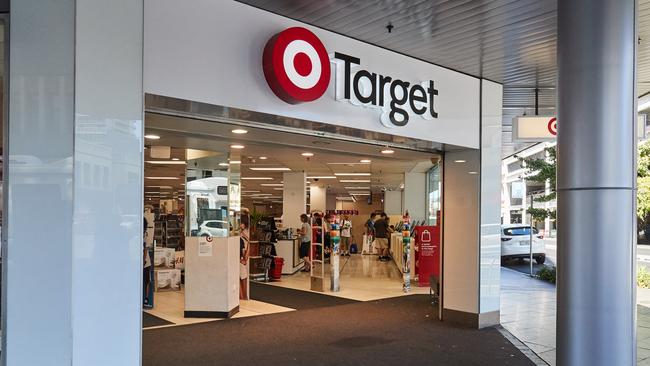Stores in struggling Target chain to close or convert to Kmart, with up to 1300 jobs axed
Wesfarmers defends axing up to 1300 jobs as it closes or rebrands around half of Target’s 284 stores, saying it must remain viable.

Wesfarmers will slash up to 1300 jobs as it takes an axe to its struggling Target brand, with around half its 284-store network shut down or turned into Kmart stores after years of underperformance and growing losses.
The sweeping changes, expected to be implemented over the next 12 months but with most in calendar year 2021, mean the end of the small-format Target Country network.
As the once famous and popular Target brand shrinks in the Australian retail landscape, the Perth-based conglomerate has also signalled nearly $1 billion in writedowns and impairments, including in its industrial and safety division.
Wesfarmers CEO Rob Scott said many Target staff would be redeployed to Kmart or other parts of its business, but between 1000 and 1300 Target workers could lose their jobs as part of the restructure.
Nationals deputy leader David Littleproud called for a consumer boycott of Wesfarmers, using the end of the Target Country network to accuse big companies of turning their back on regional Australia
“It just goes to show they don’t give a rat’s about us,” he told reporters in Toowoomba. “Australians should vote with their wallets and not go near them.”
Mr Scott defended the shutdowns and the loss of up to 10 per cent of Target’s workforce as millions of Australians face unemployment due to the coronavirus pandemic, but said it was necessary to keep the business viable.
“It is really disappointing and it is really tough when people lose their jobs, and we have been focused on doing everything we can to reduce the impact,’’ Mr Scott said.
“Notwithstanding these difficult decisions and the job losses in Target we do expect across the Wesfarmers group that we will create more jobs in Australia over the next 12 months and what we really need to do is make sure our businesses are viable for the future.”
Wesfarmers told the ASX that following the first phase of a review, the Kmart Group had identified a number of actions to “accelerate the growth of Kmart and address the unsustainable financial performance of Target”.
It would convert suitable Target and Target Country stores to Kmart stores, close between 10 to 25 large format Target stores and shut down 50 small-format Target Country stores.
There would also be a significant reduction in the size of the Target store support office.
Under the Target conversion plan, between 10 to 40 large format stores would switch to the Kmart brand, subject to landlord support, while about 52 Target Country stores would convert to small-format Kmart stores.
Wesfarmers said it was continuing its assessment of strategic options for a commercially viable Target and its remaining store network.
The massive restructure of Target follows years of its failure to consistently return profits.
Wesfarmers said restructuring costs and provisions in Kmart Group - which houses the healthy Kmart chain and the loss-making Target - would total between $120m to $170m before tax. This would primarily reflect Target store closure costs, inventory write-offs and a restructure of the Target store support office.
There would also be a non-cash impairment in Kmart Group of approximately $430m to $480m before tax, including an impairment of the Target brand name.
Wesfarmers also announced a non-cash impairment in the industrial and safety division of approximately $300m before tax, primarily relating to the impairment of goodwill.
However, helping to strengthen Wesfarmers’ finances was a pre-tax gain on sale of 10.1 per cent interest in the spun-off supermarket chain Coles of $290m, and one-off pre-tax gain of $221m on the revaluation of the remaining Coles investment.

Wesfarmers said the moves would have a “significant” impact on staff, but all workers in Target stores chosen for conversion would be offered jobs in Kmart, while those in closing Target stores would have a chance of jobs with Kmart, Catch, Bunnings or Officeworks.
However Mr Scott said between 1000 and 1300 jobs would be lost.
“We have spent a lot of time planning together with Kmart Group boss Ian Bailey and the team to see how we can minimise the job losses through this decision and in many ways we are fortunate we have a strong business like Kmart to provide redeployment opportunities,” he said.
“By pursuing this strategy it increases the number of jobs we are able to preserve, but after the redeployments that we are highly confident of to Kmart there is probably in the order of 1000 to 1300 jobs, or just under 10 per cent, of Target team whose jobs could be affected.”
Mr Scott said Wesfarmers must act to maintain profitability at its existing businesses so it could maintain its current workforce, as well as employ more people in the future.
“There is a lot of change going on in the market, not just COVID related, and if we do want to provide sustainable jobs for our teams into the future unfortunately at times we do need to make some of these difficult decisions.’’
Mr Scott said the actions taken would enhance the overall position of the Kmart Group, while also improving the commercial viability of Target.
“For some time now, the retail sector has seen significant structural change and disruption, and we expect this trend to continue,” he said.
“With the exception of Target, Wesfarmers’ retail businesses are well-positioned to respond to the changes in consumer behaviour and competition associated with this disruption.
“The actions announced reflect our continued focus on investing in Kmart, a business with a compelling customer offer and strong competitive advantages, while also improving the viability of Target by addressing some of its structural challenges by simplifying the business model.”
Mr Scott said the reduction in the Target store network would be complemented by an increased investment in digital capabilities, “following the continued strong growth in online sales across the Kmart Group and the pleasing progress in Catch since its acquisition in August 2019”.
Mr Scott said the expansion of the digital offer would provide customers with access to the Kmart and Target products, together with over two million products from the Catch marketplace, via home delivery or click and collect.






To join the conversation, please log in. Don't have an account? Register
Join the conversation, you are commenting as Logout